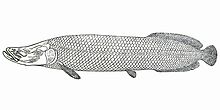| Arapaimidae | |
|---|---|

| |
| Arapaima sp. | |
| Scientific classification | |
| Domain: | Eukaryota |
| Kingdom: | Animalia |
| Phylum: | Chordata |
| Class: | Actinopterygii |
| Order: | Osteoglossiformes |
| Family: | Arapaimidae Bonaparte, 1846 |
| Genera[1] | |
| Synonyms | |
|
Sudidinae | |
Arapaimidae is a family of freshwater ray-finned fish belonging to the family Osteoglossidae. It includes the South American arapaimas of the Amazon and Essequibo basins and the African arowana (Heterotis niloticus) from the watersheds of the Sahelo-Sudanese region, Senegal, Gambia, and parts of Eastern Africa.[1] This family is sometimes treated as the subfamily Arapaiminae.[2][3] A commonly used synonym is Heterotidinae,[4] but according to the ICZN, Arapaimidae has priority.[2]
Arapaimides, along with other osteoglossomorphs, are of phylogenetic and evolutionary interest due to their trans-oceanic distribution, excellent fossil record, and position as one of the oldest living teleost lineages.[3] The type-species of the group, Arapaima gigas, is an important South American food source and charismatic representative of the region.[5] Both Arapaima and Heterotis are cultured for food in their respective countries due to their heartiness and meat, and the arapaima is a prized sport-fish, being the largest truly freshwater fish.[6]
- ^ a b Froese, Rainer; Pauly, Daniel (eds.). "Family Osteoglossidae". FishBase. July 2021 version.
- ^ a b Cite error: The named reference
:1was invoked but never defined (see the help page). - ^ a b Hastings, P. A.; Walker, Jr., H. J.; Galland, G. R. (2014). Fishes: a guide to their diversity. Oakland, California: University of California Press. pp. 62–64. ISBN 978-0-520-28353-4.
- ^ Nelson, Joseph S.; Grande, Terry C.; Wilson, Mark V. H. (2016). Fishes of the World (5th ed.). John Wiley & Sons. ISBN 9781118342336. Archived from the original on 2019-04-08. Retrieved 2021-07-16.
- ^ Stewart, J. D. (2013a). "Re-description of Arapaima agassizii (Valenciennes), a rare fish from Brazil (Osteoglossimorpha: Osteoglossidae)". Copeia. 2013 (1): 38–51. doi:10.1643/CI-12-013. S2CID 84207464.
- ^ Vitorino, R. C.; Oliverira, C.; Margarido, V. P.; Venere, P. C. (2015). "Genetic diversity of Arapaima gigas (Schinz, 1822) (Osteoglossimorpha: Arapaimidae) in the Araguaia-Tocantins basin estimated by ISSR marker". Neotropical Ichthyology. 13 (3): 557–568. doi:10.1590/1982-0224-20150037.